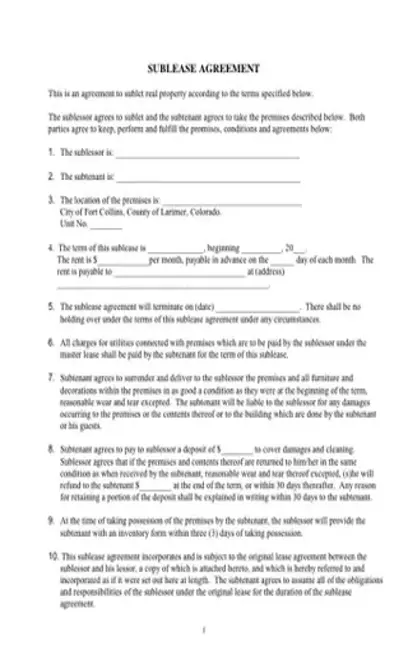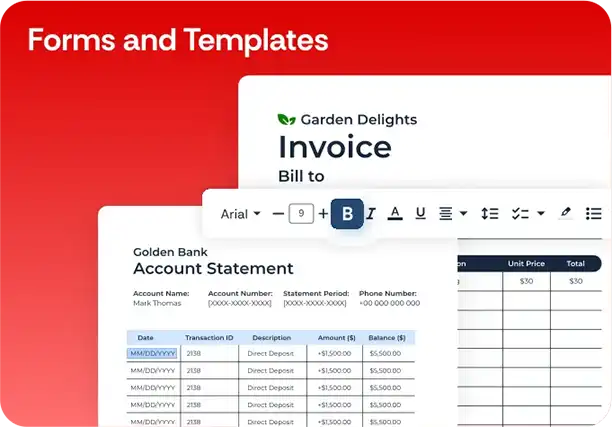Sub Lease Agreement PDF Template
Stop searching and find out why people love the ease of creating beautiful and legally compliant Sub Lease Agreement PDF with PDFSimpli.

Stop searching and find out why people love the ease of creating beautiful and legally compliant Sub Lease Agreement PDF with PDFSimpli.





Filling Out a Free Sub Lease Agreement PDF Form
A sub lease agreement is a legal and binding contract between a tenant and a secondary tenant. It is immensely important for both parties to complete and sign a lease agreement as it sets out the terms and conditions of the lease for both parties. The lease agreement authorizes the subtenant to occupy and use the residence for a specified period of time. It also specifies the amount to be paid for rent and when it is due.
A sub lease agreement is a contract that is common when an original tenant has to relocate for some reason and cannot fulfill the lease agreement. The original tenant will find someone else to take over the lease until the end of the lease term or until they can return and assume the payments. The agreement with the subtenant will be between them and the original tenant. Rarely is the landlord involved in the subletting process. In fact, there are situations in which the landlord does not have to accept the new arrangement, but as long as they are getting paid on time, it is usually not a problem. According to Investopedia, most subleases are legally binding in a court of law, unless the original lease agreement forbids subleasing.
A sub lease agreement does not invalidate the terms of the original lease. The original tenant is still directly responsible to the landlord. The subelease agreement solidifies the terms set forth by the original tenant. Additionally, the sublease agreement does not release the sublandlord from their responsibility to the landlord for any damages that may occur to the property during the sublease. It is important that the subtenant and sublandlord complete and sign the sublease and each one should retain a copy of the document for their own record.
[pdf-embedder url=”https://cdn-prod-pdfsimpli-wpcontent.azureedge.net/pdfseoforms/pdf-20180219t134432z-001/pdf/sub-lease-agreement.pdf”]
Sublease agreements are commonly used in situations in which an individual has a sudden shift in life situations that will not allow them to fulfill their lease obligations. This can be a situation in which a person’s job relocates them to another city, or it could be a college student who leaves school early. A subtenant is usually a person who is looking for short-term lodging or someone who is having difficulty getting approved for a place of their own.
Another form of subleasing is when a tenant leases a part of the apartment or home space to someone else to help reduce their cost of living in the leased property.
A sublease agreement is designed specifically for the sublandlord (original tenant) to use in the case of renting out all or part of the property to someone who is not and will not be added to the original lease. The agreement serves as a legally binding contract between the original tenant and the subtenant but does not nullify the agreement between the landlord and the original tenant. The sublease agreement can be as comprehensive as necessary, outlining all of the relevant terms and conditions of the lease agreement.
Due to the fact that basic lease agreements normally include a specified period of time, it can be difficult for a tenant to convince the landlord to release them from the terms of the contract. One simple solution is to sublease the property getting someone else to take over the responsibility of paying the rent for the specified period. As a general rule, the tenant who sublets the property will be held to the same terms set forth in the original lease agreement. The original tenant does not have the authority to extend any rights to the subletting tenant that was not initially extended to them in the original lease.
The golden rule with any type of agreement is to get all of the terms and contingencies covered in writing. By completing a Sublease agreement, there is less of a chance of confusion and misunderstanding. When there is no agreement to lay out the terms of the arrangement, any disagreement becomes a "he said, she said" situation, which can be impossible to settle in a legal forum, such as a civil courtroom.
While all sublease agreements will have certain similarities, there can be some nuances that vary from property to property and state to state. The two most important things to remember when filling out a sublease agreement is to be thorough and accurate. Don’t leave any spaces blank unless they do not apply to you, in which case you should place an "N/A" in the blank to let all other parties know that the blank was not left empty on accident.
Following are the key steps to filling out the sublease agreement.
Fill in all personal information, including your name, address, and contact information
Make sure the start date and end date are listed
Make sure that the due date is clearly listed, as well as the grace period
Any security amount should also be listed. Additionally, the manner in which the security deposit will be repaid at the end of the agreement should also be listed
Make sure to sign and date the document
It is important that both parties take the time to read the entire document. If there are any errors, make the necessary changes and make sure both parties initial and date all changes.
This is a question that every subletter should be asking. There are some instances when the owner/landlord will not approve a sublease, and it will normally be clearly stated in the original lease.
It is important to determine who will be held responsible for damages if the landlord does allow the sublease.
Choosing the right tenant is immensely important, and the original tenant should perform due diligence when selecting the person. Check payment history and background both can be done inexpensively, and it could save the sublandlord a major headache down the line.
Ask for references and actually check them